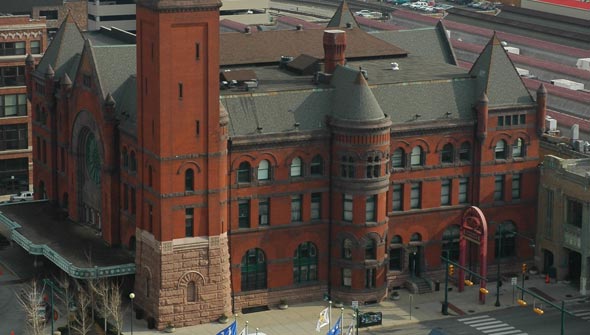Union Station
123 W. Louisiana St.

Union Stations are called that because they were built to serve as joint stations for two or more railroads instead of every railroad having its own terminal. Indianapolis was home to the world’s very first Union Station, which opened in 1853. This is not the original building, but it is pretty old. It opened in 1888, and is on the National Register of Historic Places. In its heyday, Union Station was one of the busiest train stations in the world, with over 200 trains per day by 1900.
After World War II, train travel declined here, just as it did everywhere else, and was almost gone from Indianapolis by 1970. Union Station fell on hard times and into disrepair from lack of maintenance, and the city tried to figure out what to do. In 1983, part of the train shed was renovated into a hotel that is still there as a Crown Plaza. One unique feature of the hotel is that is has a small number of authentic Pullman sleeping cars from the 20’s for rooms, which are still sitting on the tracks. In 1986 the rest of the station was renovated into a small shopping center at a cost of $30 million, but this lost most of its traffic after the nearby Circle Centre Mall opened. The marketplace in Union Station closed in 1997. After that, the building was given over to private tenants. Perhaps the most prominent tenant today is the Mexican Consulate.
The building is very striking and is done in a style called Romanesque Revival that was popular in its day. It is so-called because it was a resurrection of a style called, not surprisingly, Romanesque that was popular in the 11th and 12th century, especially in France and Spain. The use of arches was one of the signatures of this style, of course hearkening back to the Romans. You can see both the large arches on the ground floor and the arched windows on the third. Other elements of this style are the horizontal belts of stone you see, called belt courses. The style was widely used for churches, and you can clearly see the resemblance between Union Station and a cathedral.
The architect was Thomas Rodd of Pittsburgh, who did a great job as this building is one of the best examples of this style in the Midwest. And not just on the exterior. The interior is also very striking, with a huge, skylit barrel vaulted ceiling running the length of the waiting room.
Romanesque Revival was a popular style for Union Stations. For example, if you ever travel to places like Louisville or Nashville, you’ll be able to instantly recognize their Union Stations, since they are done in a very similar design, albeit with gray stone instead of red and by different architects. This building is older than those, by the way.
There’s actually still train service here today. Amtrak runs one train a day, accessed from a small joint station with Greyhound on the south side of the tracks. By the way, the huge seven acre train shed on the back may not look like much, but it contains fourteen elevated tracks and is one of less than a dozen such structures surviving in America today.
